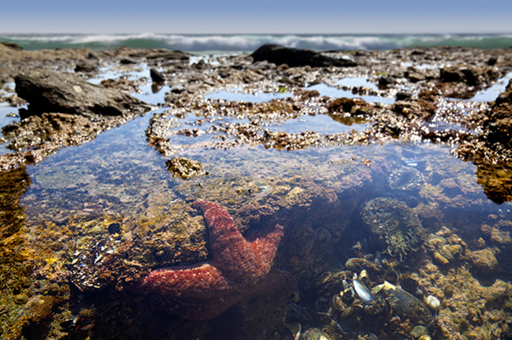2.1 The rockpool
Like all ecosystems, a rock pool is linked to the wider world and to other ecosystems. This link is most apparent in the shape of the tides every day, which change the sea water in the pool and bring in new organisms from the open ocean (as well as allowing others to escape back into the sea). The tides also change the physical characteristics of the pool and its surroundings. When the tide is out, the rock pool is a collection of organisms living together in a fairly clearly defined place. When the tide is in, the pool may become no more than a small depression on the rocky sea bed.
Now let’s look at the components of our rock pool ecosystem. Remember, any ecosystem contains living things, a physical environment and a source of energy.
The most obvious living things will tend to be the largest ones: seaweeds, sea anemones, whelks, shrimps, fish and so on. But this shouldn’t blind us to the importance of the organisms we can’t see. For example, the water itself is full of tiny plants and animals – called ‘plankton’ – that are food for many of the larger creatures. And the water and rocks contain huge numbers of the simple single-celled organisms called bacteria, and other microscopic forms of life, that play an important part in the working of the ecosystem.
The most obvious components of the physical environment of the pool are the rock that surrounds it, the sea water in it, and the air above it (when the tide is out). But these physical factors are far from fixed. The tides, and the effect of sunlight on the exposed pool, mean that the organisms that live in it must be able to withstand changes and extremes of, for example, temperature or salt content. Some small pools dry up altogether in the summer or ice over in winter when the tide is out.
Almost all of the energy that supports the life in the pool arrives in the form of light from the sun. Some of this energy is captured by seaweeds attached to the rocks and microscopic plants (types of plankton). These plants are eaten by animals, which are eaten by other animals, and so on. But the sun is not the only source of energy involved in the workings of this particular ecosystem: the tides that sweep across the pool are driven up and down the beach by the gravitational pull of the moon.
Activity 1
Using your knowledge of rock pools, pick out a few of the key features of the ecosystem, using these headings:
- rock pool ecosystem – links to other ecosystems and the wider world
- ecosystem
- living things
- physical environment
- energy.
Make some note on the key features, in the box below.
Answer
Here is a list of key features for each heading:
- rock pool ecosystem – links to other ecosystems and wider world
- ecosystem – living organisms, physical environment, energy
- living things – plants, animals, plankton, bacteria
- physical environment – rock, sea water, air, tides
- energy – sunlight (also tides caused by pull of the moon).
Did you note many of the same points? Is there anything else you’d include? Is there anything you’d leave out?
Remember that it is the observer – you or I – who defines an ecosystem, and selects which organisms or aspects of the environment to study. In much the same way, you have to decide what is important when you make notes.
However big or small our ecosystem, and whichever aspect of the system we choose to study, it is ecology that provides the framework that allows us to investigate how it works – and to wonder at the beauty and strangeness of it all.

